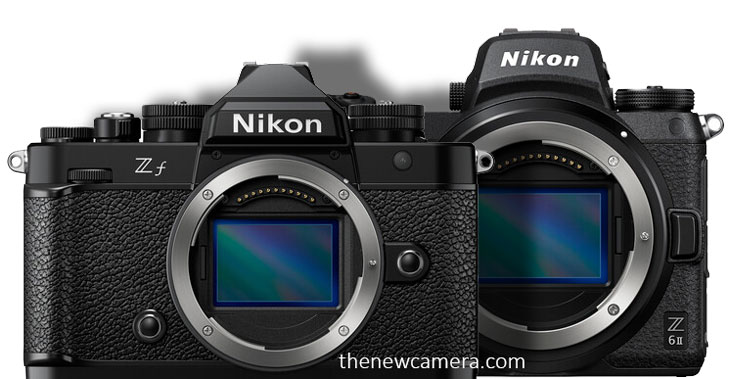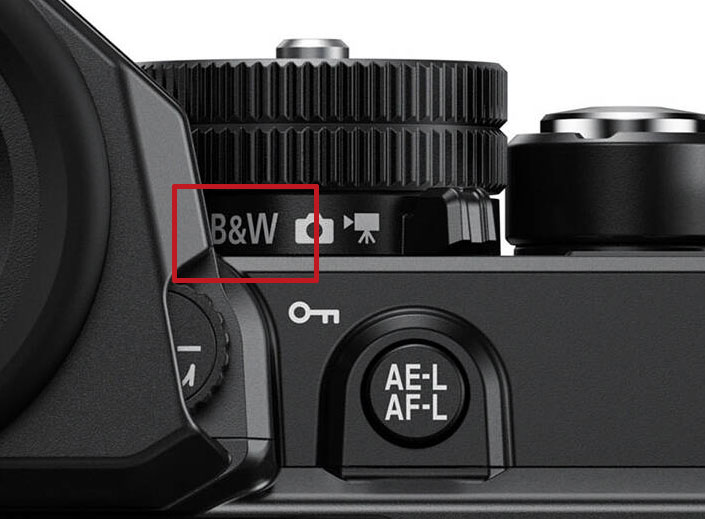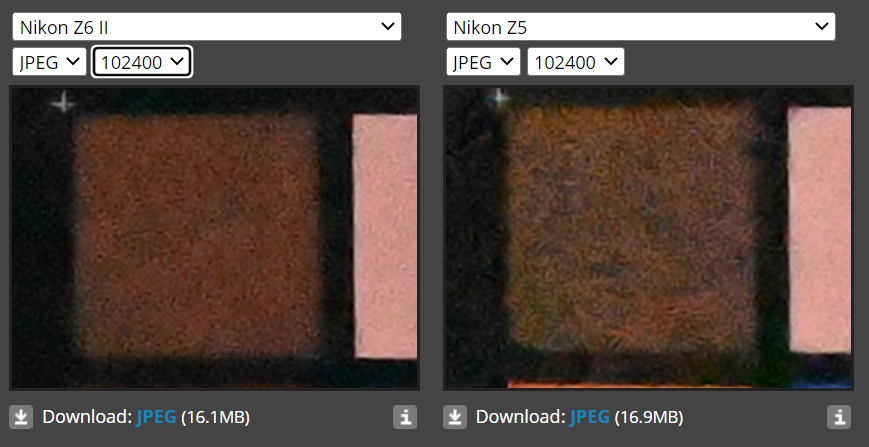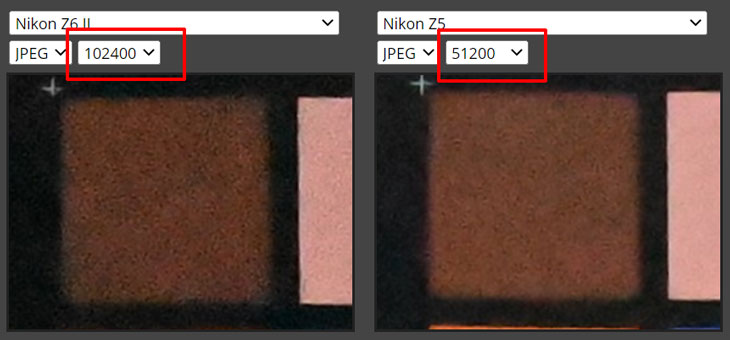
Let’s compare the two full-frame cameras that fall almost in the same price range: the Nikon ZF and the Nikon Z6 Mark II. We will try to find out the best camera for you according to the core differences between them and the body design type.
Apart from the basic specs differences, in the design part, the Nikon ZF camera is a kind of retro-style camera with extensive manual controls. The look of the camera is really brilliant and very attractive for a professional photographer. Without a doubt, if you have to compare the look of both cameras, ZF is a clear winner.
| Feature | Nikon ZF Camera | Nikon Z6 Mark II Camera |
| Display Screen | Vari-angle-adjustable | Tilting |
| Top LCD Display Screen | Mini Display | Large |
| Full Size HDMI | Yes | No |
| Black and White Mode | Dedicated black and white mode with two different options: Flat mono and Deep tone mono | Normal black and white mode |
| Memory Card Slots | Dual card memory slots with one slot for UHS-II and the other for MicroSD UHS-I | Dual card memory slots with one slot for CF Express Type B cards and the other for UHS-II cards |
1. VLOGGERS FRIENDLY
The Nikon ZF camera features a vari-angle-adjustable display screen on the rear side of the camera. This screen not only helps photographers to have compositional freedom, but it is also very helpful for content creators who create online content for YouTube, Instagram, or TikTok.
In contrast, the Nikon Z6 Mark II camera has a tilting display screen on the rear side of the camera, which is not as helpful for content creators. It also limits the compositional freedom of a photographer. feature that is absent in the Nikon ZF camera is the top LCD display screen that you find in the Nikon Z6 Mark II. The Nikon ZF has a smaller display screen that shows the aperture value of the lens when the camera is on. This could be a consideration depending on your specific needs and preferences in a camera.

2. BLACK AND WHITE
Dedicated black and white mode present in the Nikon ZF camera. Now, what is so important about this black and white mode or the monochrome of the Nikon ZF camera? The Nikon ZF camera monochrome profile features two different options: one is Flat mono and the other is Deep tone mono. The Deep tone mono accentuates red details in the scene. Both of them can be used in stills as well as in video footages. So, it is not just a normal black and white mode that we see in a normal Nikon camera. It does have profiles and in the future, we may have more profiles added to the mono through updates.”
3. MEMORY CARD SLOTS
The Nikon ZF camera and the Nikon Z6 Mark II camera both have dual card memory slots. However, in the Nikon ZF camera, due to the compact design, engineers have included a Micro SD card slot. So, one card slot is for UHS-II, and the other card slot is for MicroSD UHS-I. This is highly suitable for photographers for keeping a backup file.
In the Nikon Z6 Mark II camera, we have two different card slots. One accepts CF Express Type B cards and the other is designed for UHS-II cards. Now it depends on you whether you want to invest in CF Express Type B cards or you want to invest in UHS-I and Micro SD cards. The latter could be a more affordable option for you if you are a photographer.
| Feature | Nikon ZF | Nikon Z6 Mark II |
| Sensor | 24-megapixel FX format full-frame CMOS sensor | 24-megapixel FX format full-frame CMOS sensor |
| Image Processor | Uses the advanced Expeed 7 image processor, same as in the Nikon Z9 flagship camera | Uses an older image processor |
| High-Efficiency RAW | First NIKON camera in this price range to feature high-efficiency RAW compression, allowing shooting in 10-bit HEIF format, an alternative to standard 8-bit JPEG images | Does not have this feature |
| High-Resolution Mode | Features a multi-shot pixel shift high-resolution mode, able to capture images up to 96 megapixels with the help of its advanced image stabilization system | Does not have this feature |
| Image Stabilization | Very advanced, uses an AI algorithm to optimize the performance of the sensor-shift image stabilization unit. The IS system moves along with the autofocus point of the camera, offering off-center image stabilization support | Does not offer off-center image stabilization support |
4. SENSOR OF BOTH THE CAMERA
Both the Nikon ZF and the Nikon Z6 Mark II cameras feature the same 24-megapixel FX format full-frame CMOS sensor. However, the biggest difference is created by the image processor used in both cameras. The Nikon ZF features a very advanced image processor, the Expeed 7, which is the same image processor being used in the Nikon Z9 flagship camera.
5. High-Efficiency RAW
After the Nikon Z9 and Nikon Z8, the Nikon ZF camera is the first camera to feature high-efficiency RAW compression, which is possible with the introduction of the new Expeed 7 image processor inside the camera. The high-efficiency RAW format allows a photographer to shoot 10-bit in HEIF format, which is a perfect alternative to the standard 8-bit JPEG images.
6. A 96 MP HIGH-RESOLUTION MODE
The Nikon ZF camera features a multi-shot pixel shift high-resolution mode. With the help of its advanced image stabilization system, the camera is able to capture higher resolution images up to 96 megapixels, which is certainly not possible with the Nikon Z6 Mark II camera
7. iMAGE STABILIZATION ATTACHED WITH AF POINT
The image stabilization of the latest Nikon ZF camera is very advanced and uses an artificial intelligence algorithm to optimize the overall performance of the sensor-shift image stabilization unit. The camera’s IS system moves along with the autofocus point of the camera, so the center of stability moves along with the subject in focus. Currently, no other camera offers off-center image stabilization support like the Nikon ZF does.
| Feature | Nikon ZF | Nikon Z6 Mark II |
| Autofocus System | Uses the latest Expeed 7 image processor and advanced AI autofocus algorithms. Able to track a wide variety of animals and vehicles. The autofocus system covers approximately 96% of the horizontal axis of the image area3. The AF sensitivity extends down to -10EV. | Uses an older image processor. Recognition is limited to humans and animals. The autofocus system covers approximately 90% of the sensor area. |
| AF Sensitivity | Able to autofocus up to -10 EV, allowing it to shoot in nearly dark environments. | Autofocus sensitivity is limited to -4.5 EV4. |
| Continuous Shooting Speed | Maximum shooting speed is 30 fps in C30 mode. Able to capture RAW files of any type up to 14 fps. | Maximum shooting speed is 14 fps for 12-bit RAW images and 10 fps for 14-bit RAW images. |
8. Autofocus
Both cameras feature the same sensor with the same number of hybrid autofocusing points, but the big difference is the type of image processor used in each camera. The Nikon ZF camera uses the latest Expeed 7 image processor. Not only is the image processor new, but the camera also uses advanced artificial intelligence autofocus algorithms that are being used in the Nikon Z9 and Nikon Z8 cameras. The same artificial intelligence AF algorithm is being implemented in the Nikon ZF camera, so the 3D object tracking has improved a lot compared to the Nikon Z8. Now, the camera is able to track a wide variety of animals including birds as well as vehicles like cars, motorbikes, and planes. The Nikon Z6 Mark II camera’s recognition is limited to humans and animals only
9. AF SENSITIVITY LIKE NO OTHER
The autofocus sensitivity of the Nikon ZF camera is the best among all Nikon mirrorless cameras right now. The Nikon ZF is able to autofocus up to -10 EV, whereas the Nikon Z6 Mark II’s autofocus sensitivity is limited to -4.5 EV. This clearly indicates that the Nikon ZF camera is able to shoot in nearly dark environments, which is not possible with the Z6 Mark II. The sensitivity of the Nikon ZF is not only the best in its class, but it is also similar to today’s flagship cameras.
10. CONTINUOUS SHOOTING SPEED
The maximum shooting speed of the Nikon ZF camera is 30 frames per second. To achieve this speed, you have to put your camera in C30 mode where it records video at 30 frames per second and you are able to extract any frame that you like. C30 mode is available in the burst mode of the camera. In contrast, the Nikon ZF camera is able to capture RAW files of any type up to 14 frames per second, whereas the Nikon Z6 Mark II camera is able to capture 14-bit RAW images up to 10 frames per second and 12-bit RAW images up to 14 frames per second. It also gives you an option to record 30 frames per second when it is required.
| Feature | Nikon ZF | Nikon Z6 Mark II |
| Videographics Resolutions | 4K videos at 24, 30, and 60 fps (with 1.5x crop or DX crop at 60 fps) | 4K videos at 24, 30, and 60 fps (with 1.5x crop or DX crop at 60 fps) |
| 10-bit Video Recording | Internally in H.265 codec | Only possible with HDMI output (requires external recorder) |
| Shutter Priority Mode | Available (with Manual adjustments to ISO and aperture in Shutter Priority) | Not available |
| Recording Limit | Up to 125 minutes for 4K videos at either 24 or 30 fps | Limited to 30 minutes |
11. Best camera for video
Both the Nikon ZF and Nikon Z6 Mark II cameras feature the same videographic resolutions. Both are able to capture 4K videos at 24 and 30 frames per second without any crop. When you switch to 4K videos at 60 frames per second, you have to face a 1.5x crop or you can set DX crop. The biggest difference you will notice is that the Nikon ZF camera is able to record 10-bit videos internally in H.265 codec, whereas with the Nikon Z6 Mark II camera, 10-bit video recording is only possible with HDMI output. So, if you want 10-bit videos with the Nikon Z6 Mark II camera, you have to use an external recorder, whereas with the Nikon ZF, you can record 10-bit videos directly onto your memory card.
The Nikon ZF camera also allows you to record your video in shutter priority mode with automatic adjustments to ISO and aperture, meaning a bit more manual control is unlocked in the ZF body compared to the Z6 Mark II.
12. NIKON Z6 MARK II 30 MIN RECORDING LIMIT
The recording limit in the Nikon Z6 Mark II camera is 30 minutes, whether you are shooting a full HD video or recording a 4K movie. On the other hand, with the Nikon ZF, you can record up to 125 minutes without any interruption for 4K videos at either 24 or 30 frames per second
Conclusion
if you look at the detailed comparison then if you are a photographer for a videographer without a doubt Nikon ZF camera is more suitable for you.









